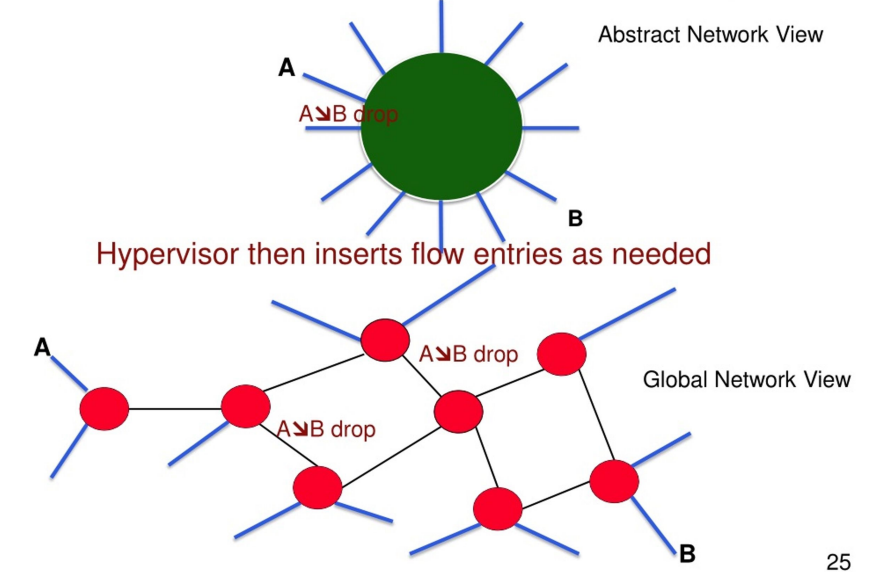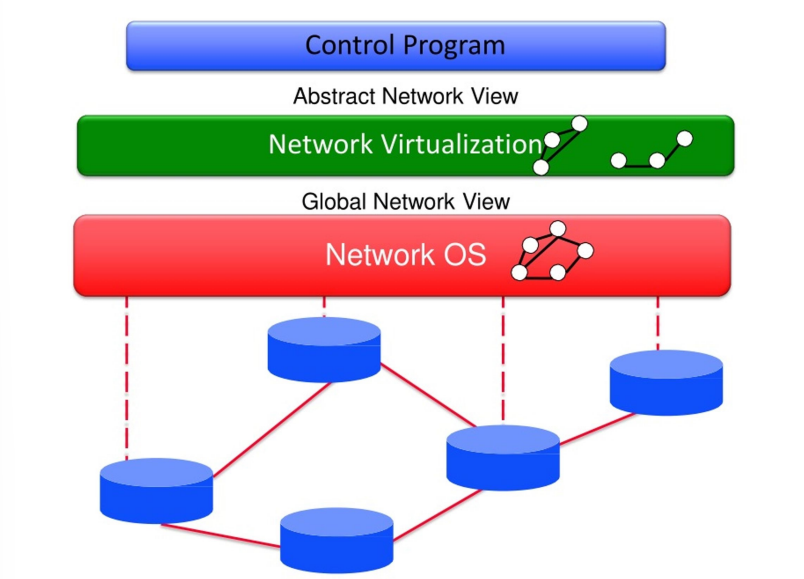CMSC 137 - Software Defined Networks (SDN)
1/50
There's no tags or description
Looks like no tags are added yet.
Name | Mastery | Learn | Test | Matching | Spaced |
|---|
No study sessions yet.
51 Terms
[Short History of SDN] 2004
Research on new management paradigms
RCP, 4D [Princeton, CMU,....]
SANE, Ethane [Stanford/Berkeley]
[Short History of SDN] 2008
Software-Defined Networking (SDN)
NOX Network Operating System [Nicira]
OpenFlow switch interface [Stanford/Nicira]
[Short History of SDN] 2011
Open Networking Foundation (~69 members)
Board: Google, Yahoo, Verizon, DT, Microsoft, Facebook, NTT
Members: Cisco, Juniper, HP, Dell, Broadcom, IВМ,
[Short History of SDN] 2013
Latest Open Networking Summit
1600 attendees, Google: SDN used for their WAN Commercialized, in production use (few places)
Why Was SDN Needed?
Networks are hard to manage
Networks are hard to evolve
Networks design not based on formal principles
[Why Was SDN Needed?] Networks are hard to manage
Computation and storage have been virtualized
Creating a more flexible and manageable infrastructure
Networks are still notoriously hard to manage
Network administrators large share of sysadmin staff
[Why Was SDN Needed?] Networks are hard to evolve
Ongoing innovation in systems software
Routing algorithms change very slowly
Network management extremely primitive
Networks are stuck in the past
New languages, operating systems, etc.
[Why Was SDN Needed?] Networks design are not based on formal principles
OS courses teach fundamental principles
Mutual exclusion and other synchronization primitives
Files, file systems, threads, and other building blocks
Networking courses teach a big bag of protocols
Networks used to be simple
Basic Ethernet/IP straightforward, easy to manage
New control requirements have led to complexity
ACLs, VLANs, TE, Middleboxes, DPI,...
The infrastructure still works…
Only because of our great ability to master complexity
Ability to master complexity both blessing and curse
How Programming Made the Transition
Machine Languages: No Abstractions
had to deal with low-level details
Higher-level Languages: OS and other Abstractions
file system, virtual memory, abstract data types
Modern Languages: Even More Abstractions
object orientation, garbage collection
Abstraction
simplify programming
the way we extracted simplicity
The Two Networking “Planes”
Data Plane
Control Plane
Data Plane
processing and delivery of packets with local forwarding state
forwarding state + packet header → forwarding decision
Control Plane
compute the state in routers (forwarding state)
Determines how and where packets are forwarded
Routing, traffic engineering, firewall state
Implemented with distributed protocols, manual configuration (and scripting) or centralized computation
Data Plane Abstractions: Layers
Applications
...built on...
Reliable (or unreliable) transport
...built on...
Best-effort global packet delivery
...built on...
Best-effort local packet delivery
...built on...
Local physical transfer of bits
[Many Control Plane Mechanisms] Variety of Goals
Routing: distributed routing algorithms
Isolation: ACLs, VLANs, Firewalls, etc.
Traffic engineering: adjusting weights, MPLS, etc.
[Many Control Plane Mechanisms] modularity
no _____, limited functionality
[The Control Plane Problem] forwarding
Control plane must compute _____ state. To accomplish its task, the control plane must:
Figure out what network looks like (topology)
Figure out how to accomplish goal on given topology
Tell the switches what to do (configure forwarding state)
SDN: Two Control Plane Abstractions
Global Network View
Forwarding Model
Global Network View
one of the two control plane abstractions
provides information about current network
implementation: "Network Operating System"
runs on servers in network (replicated for reliability)
Forwarding Model
one of the two control plane abstractions
provides standard way of defining forwarding state
this is OpenFlow
specification of <match,action> flow entries
OSPF and Dijkstra
example of using a Global Network View to compute optimal paths
shows the idea of local routers using a global map
Load Balancing
example of using the Forwarding Model to dynamically control how traffic flows
Specification Abstraction
Control program must express desired behavior
Whether it be isolation, access control, or QoS
It should not be responsible for implementing that behavior on physical network infrastructure
Requires configuring the forwarding tables in each switch
Proposed abstraction: Virtual Topology of network
Virtual Topology models only enough detail to specify goals
Will depend on task semantics
Network Virtualization
introduce new abstraction and new SDN layer
[Network Virtualization] Virtual Topology
Abstraction: _____
Allows operator to express requirements and policies
Via a set of logical switches and their configurations
[Network Virtualization] Network Hypervisor
Layer: _____
Translates those requirements into switch configurations
"Compiler" for virtual topologies
Virtualization
_____ Simplifies Control Program

[Clean Separation of Concerns] Control Program
express goals on Virtual Topology
Operator Requirements
Configuration = Function(view)
Not a distributed protocol, now just a graph algorithm
SDN: Layers for the Control Plane

Complexity
Abstractions Don’t Eliminate _____
[Abstractions Don’t Eliminate Complexity] tractable
every component of system is _____
NOS, Virtualization are still complicated pieces of code
[Abstractions Don’t Eliminate Complexity] SDN Main Achievements
simplifies interface for control program (user-specific)
pushes complexity into reusable code (SDN platform)
Killer App
Virtualization is _____ for SDN.
it allows multiple tenants in a data center to each have their own custom virtual network, while still sharing the same physical infrastructure
Four Crucial Points
SDN is merely set of abstractions for control plane
Not a specific set of mechanisms
OpenFlow is least interesting aspect of SDN, technically
SDN involves computing a function....
NOS handles distribution of state
...on an abstract network
Can ignore actual physical infrastructure
Network virtualization is the "killer app"
Already virtualized compute, storage; network is next
SDN Larger Implications
Control/Data Planes Become Separate
Networking Becomes Edge-Oriented
[SDN Larger Implications] Control/Data Planes Become Separate
Currently control plane tied to data plane
NOS runs on servers: observes/controls data plane
Changes the deployment and business models
Can buy the control plane separately from the switches
Enabling commodity hardware and 3rd party software
Changes the testing model
Simulator to analyze large-scale control planes
[SDN Larger Implications] Networking Becomes Edge-Oriented
Can implement most control functionality at edge
Access control, QoS, mobility, migration, monitoring...
Network core merely delivers packets edge-to-edge
Current protocols do a good job (mostly)
Let edge handle all complexity
Complicated matching, actions
"Overlay" networking via tunnels
This has two important implications
Makes SDN Incrementally Deployable
Networking Becomes Software-Oriented
[Networking Becomes Edge-Oriented - Implication] Makes SDN Incrementally Deployable
Host software often has OpenFlow switch
Open vSwitch (OVS) in Linux, Xen,...
The edge becomes a software switch
Core of network can be legacy hardware
Enables incremental deployment of SDN
Might never need OpenFlow in hardware switches....
[Networking Becomes Edge-Oriented - Implication] Networking Becomes Software-Oriented
All complicated forwarding done in software (edge)
And control plane is a program (on a server)...
...not a protocol (on a closed proprietary switch/router)
We are programming the network, not designing it
Focus on modularity and abstractions, not packet headers
Innovation at software, not hardware, speeds
Software lends itself to clean abstractions
SDN Vision
Networks Become “Normal”
[SDN Vision] Hardware
Cheap, interchangeable, Moore's Law
[SDN Vision] Software
Frequent releases, decoupled from HW
[SDN Vision] Functionality
Mostly driven by SW
Edge (software switch)
Control program
[SDN Vision] foundations
solid intellectual _____
OpenFlow
a key protocol used in Software-Defined Networking (SDN) that allows the controller to talk to switches and routers
It lets the controller send "match-action" rules to switches
[Primitives <Match,Action>] Match
Match on any header, or new header
Allows any flow granularity
[Primitives <Match,Action>] Action
Forward to port(s), drop, send to controller
Overwrite header with mask, push or pop
Forward at specific bit-rate
[SDN “Implementations” - Software/Hardware] Forwarding Model
OpenFlow
ForCES
[SDN “Implementations” - Software/Hardware] Software Switches compliant with OpenFlow std.
Open vSwitch
Pantou/OpenWRT
Ofsoftswitch13
Indigo
[SDN “Implementations” - Software/Hardware] Controller compliant with OpenFlow std.
POX
NOX
MUL
Maestro
[SDN “Implementations” - Software/Hardware] Available Commodity Switches compliant with OpenFlow std.
Hewlett-Packard 8200zl, 6600, 6200zl
Brocade 5400zl, and 3500/3500yl
IBM Netlron CES 2000 Series